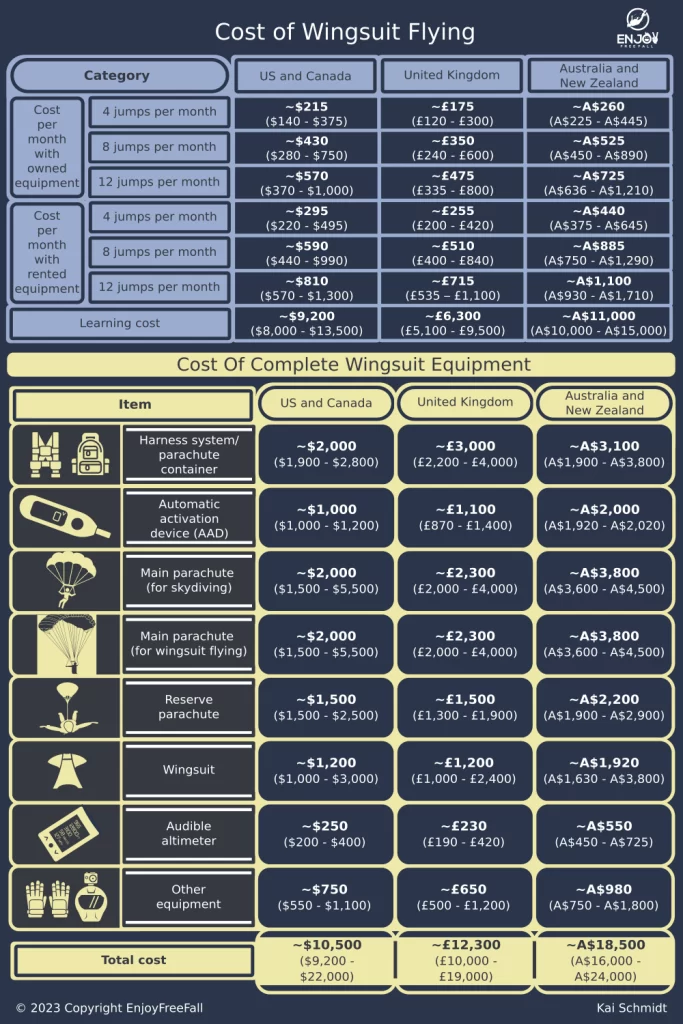
Wingsuits give their wearer the necessary air resistance to glide through the air and perform incredible jumps. But what materials can be used to provide humans with “wings”?
Wingsuits are made of ripstop nylon that is reinforced by stronger material such as carbon fiber at the leading edge on the shoulders, arms, and legs. Many manufacturers patent their own modified version of ripstop nylon to gain a competitive advantage.
More specifically, there are some differences in the material depending on the part of the suit and the type of wingsuit. There are currently also some pioneers that developed new types of wingsuits such as tandem wingsuits and jet-powered wingsuits, requiring slightly different materials.
The Materials and Parts of a Modern Wingsuit
Wingsuit manufacturers have to optimize for stability, durability, and low weight in order to design a high-performing and reliable wingsuit. As a result, they will use different materials for different parts of the wingsuits.
| Wingsuit Part | Description and Function | Material |
| Wings | They are located under the arms and between the legs to create the shape of an airfoil. | (Ripston) nylon |
| Air inlets | The air inlets inflate during jumping. They are located at the arm and leg wings which is ideal for BASE jumping and maximum stability. Bonus: Some skydivers customize their wingsuits and add a back inlet for back flying. The position and count of inlets vary depending on the wingsuit designs. | (Ripston) nylon |
| Leading edges | They help maintain the shape of the wings. | Soft and performance foam reinforced by carbon fiber |
| Booties | They allow your lower legs to be more responsive to slight movements and to easily perform turns, slides, and forward movements. | Rubber made from polyurethane or leather |
| Cutaway system (zippers) | Wingsuits have side arm zippers to easily reach the parachute steering toggles and side leg zippers for a more comfortable ride while under the canopy as well as chest zippers to easily get in and out of the wingsuit. | Aluminum, nylon or polyester |
| Internal ribs | They help to maintain the wingsuit’s shape and create internal pressure. | Terylene, kevlar, or nylon |
| Chest pockets | They are used to store cellphones and hold the chest altimeter and camera in place (e.g., belly cam shot) | Polyester or polycotton |
As you can see, most parts of the wingsuit are made of ripstop nylon (or some patented version of it), because ripstop nylon combines the above-mentioned criteria quite well.
Ripstop nylon is a lightweight woven fabric with zero porosity (air cannot pass through) allowing for lift during the jump. It is also quite durable and resistant to common rips and tears. You might know ripstop nylon fabrics from parachutes, hot air balloons, yacht sails, and camping equipment such as tents, hammocks, and sleeping bags.
Wingsuits manufacturers can create a competitive advantage when using superior materials. As a result, they often partner with chemical companies to develop new materials.
For example, newer models of Birdman wingsuits are made of 210D double-coated extra sturdy nylon with internal ribs made from Mylar (a polyester film made from polyethylene terephthalate). Phoenix-Fly wingsuits on the other hand are made of Parapack nylons on the top surface and UL bottom skin with inside panels for higher internal pressure and speed.
Materials used for wingsuits also have come a long way since the invention of wingsuits. If you are interested in knowing more about the incredible invention story of wingsuits, check out this post.
Do The Materials Used in Wingsuits and Skydiving Jumpsuits Differ?
The materials of skydiving jumpsuits and wingsuits differ but come from the same “material family”. Common parts of skydiving jumpsuits and wingsuits such as zippers are usually made of the same material.
Wingsuit manufacturers design their suits with a focus on safety and accessibility while jumpsuit manufacturers focus on flexibility, protection, and comfort. Here are some of the differences:
- Jumpsuit “body” including wings: Wingsuits and skydiving jumpsuits are both made of specialized nylon. However, wingsuits are made of ripstop nylon whereas skydiving jumpsuits are made of Cordura or Spandex. Spandex is a very breathable material and therefore has more wearing comfort. It cannot be used for wingsuits because it requires more surface to create lift than ripstop nylon. Therefore, it would be much more difficult to reach the required glide ratio of 3:1 with Spandex (i.e., 3 meters of horizontal glide for every 1 meter of vertical descent).
- Booties, knees, and buttocks: Wingsuits have rubber or leather booties for more power and stability. Wingsuits need strong booties because they are used to create tension in the wings. Knees and buttock protection of skydiving jumpsuits, in contrast, are mostly made of Cordura, a durable material that is not as strong as rubber and leather.
- Leading edges: The shoulder parts of skydiving jumpsuits are often made of Spandex. The shoulders of wingsuits are connected to the leading edges of the wings. They are essential to creating the necessary tension in the wings and therefore are reinforced by carbon fiber and protected by foams.
If you want to learn more about the different materials used in skydiving jumpsuits and how they affect the jumping experience, you can check out this post.
Do The Materials Of Wingsuits Differ Between Wingsuit Types
The materials used for wingsuits do not differ depending on the wingsuit type. The composition and thickness, however, can differ depending on the usage requirement and level of the wingsuit pilot.
Beginner wingsuits are ideal for skydivers with zero wingsuit experience. They have small wings that are designed to gradually introduce skydivers to the world of wingsuit flying. Counterintuitively, beginner wingsuits have often less supported leading edges, making it easier to regain control once the wingsuit got out of control.
| Level of Wingsuit Pilot | Requirements |
| Beginner Wingsuits | Upon completion of the Wingsuit First Flight Course |
| Intermediate Wingsuits | Minimum of 35 wingsuit jumps |
| Advanced Wingsuits | Minimum of 200 wingsuit jumps |
Intermediate wingsuits require at least a minimum of 35 wingsuit jumps. They are great transitioning suits as piloting skills progress. Intermediate wingsuits already have larger surface areas, providing a huge amount of power. They are perfect for camerawork, head-down flying, belly position, and flying formations.
Advanced (Expert) wingsuits require a minimum of 200 wingsuit jumps. They are designed for competition and often have large surface areas with strongly supported leading edges. They also often have air inlets at the back allowing for more risky maneuvers.
Depending on the type of jump (e.g., XRW flying, BASE jumping) they have different characteristics with different power levels, maximum speeds, and flexibility levels.
Different wingsuit characteristics and types of jump allow for a high variety in wingsuit flights. However, if you feel like you are getting bored by wingsuit flying, check out my article about the 13 activities that you will enjoy if you like skydiving. It will inspire you to go onto your next adventure!
Is There a Specialized Wingsuit for Tandem Skydiving?
There are specialized wingsuits for tandem wingsuit flying even though only a few manufacturers produce them. With an increase in the popularity of tandem wingsuit flying more manufacturers will start developing their own tandem wingsuit suits.
Commercial tandem wingsuit flying was not available until recently. Back then, pioneers experimented with available skydiving equipment such as a tandem parachute rig and wingsuit, then from there they improvised and just made adjustments accordingly.
For instance, in 2017, wingsuit pilot Jarno Cordia and tandem master Tjalle Den Ouden jumped out of an airplane to perform their first wingsuit tandem flight. Tjalle wore a tandem parachute rig and had a parachute on his back while he attached himself to the wingsuit worn by Jarno who served as a tandem passenger. Jarno glided through the sky using the wingsuit while Tjalle focused on parachute deployment. Together they successfully steered their way back to the ground.
In 2021, Vincent “Le Blond” Descols and his Skyvibration team brought tandem wingsuit flying to the general public and allowed everyone to take on this breathtaking journey that defies gravity, allowing them to taste the freedom of flight. If you would like to learn more about how tandem wingsuit flying works, I have a dedicated article called “The Ultimate Guide to Tandem Wingsuit Flying” where I explain everything you need to know such as the requirements, mechanics, training, cost, and everything in between.
What Are Jet-Powered Wingsuits Made Of?
Over the years, several experiments have been made to develop a powered wingsuit, some using materials like small turbojet engines attached to the feet while others have created a wing pack system attached to the back of the pilot.
The material is not much different from normal wingsuits. However, jet-powered wingsuits (not commercialized yet) often have special forms of nylon that is heavier but more resistant (even fireproof) and durable. This is reasonable because you do not want the wingsuit to heat or break while being attached to a “jet engine”.
The most renowned, jet-power wingsuit project was completed in October 2019. After the final test of his prototype, Jarno Cordia exited an aircraft from an altitude of 5,000 ft with a pair of jet boots and fuel tanks attached to the back of his wingsuit. He had a successful flight at 4,000 ft which lasted for 2 minutes and 48 seconds and covered a distance of 2.9 mi (4.8 km).
Wingsuit flying as a sport is continuously evolving. Many pioneers push the boundaries through the usage and development of new materials and inventions to improve the human flying experience.
Technology continues to push the boundaries of wingsuit flying, and so do current daredevils. To learn more about the fascinating wingsuit jumps check out my articles about how fast can a wingsuit go and the 13 most mind-blowing wingsuit flights.
Enjoy your freefall using a wingsuit!



